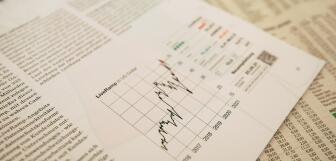Boost Retail Success with Smart Business Cashflow Analysis
As the owner of a retail or hospitality business, the way that you manage your finances can have a massive impact (be it negative or positive) on the success of your company.
Carrying out a cash flow analysis and monitoring your company's cash flow statement is one of the top ways to work out your financial health and tell if you're barely breaking even or succeeding.
Around 20% of businesses don't make it past their first year, according to the US Bureau of Labor Statistics. 65% fail by the tenth year, with a lot of these businesses attributing cash flow problems as the main reason for this failure.
One way to avoid falling into this percentage, to not be part of that 65%, is by carrying out regular cash flow analysis. It can help you make the right choices about your operations and investments. Today, we're going to show you how.
What is cash flow in business?
The first thing we're going to do is really get clear on what cash flow means. After all, to carry out a cash flow analysis successfully, you need to be able to fully understand it.
Definition and importance
Cash flow means the money that's moving in and out of your business.
Positive cash flow means your business has more money coming in than going out. You can pay your bills and still have some money left over for financing activities.
Negative cash flow is the opposite. You're spending more than you're earning, which can lead to trouble if it keeps happening, as it becomes hard to continue funding your operation.
The below chart shows you some common characteristics of each:
|
Positive |
Negative |
|
Enough money to pay bills on time |
If you have slow-paying customers, they cause crunches (cash shortages) |
|
Enough cash to meet your payroll |
Meeting payroll is challenging |
|
Money left over to scale your business |
Unexpected payments cause a cash flow issues |
Difference between cash flow and profit
Oftentimes, people mistake the term profit for cash flow. But they're actually quite different.
Profit is what’s left over after you’ve paid all your expenses. It’s the amount your business earns.
Cash flow, on the other hand, is about the timing of money coming in and going out. You may be profitable on paper, for example, but that doesn't mean that you can't have cash flow problems if your income doesn’t arrive in time to cover the expenses you owe.
Types of cash flow
There are three different sections you'll find on a cash flow statement. These are:
Operating cash flow
Operating cash flow is the money your business makes from day-to-day activities.
It includes things like money owed to you (we call this accounts receivable), money you owe (accounts payable), and taxes you need to pay.
For example, if a customer pays an invoice, that payment counts as cash from business operations. Any changes in short-term assets or debts, things due within a year, are included in this section too, under accounts payable as it’s money you owe.
Investing cash flow
This part of the cash flow statement shows money spent on and earned from long-term investments like buying or selling property, pricey equipment, or other big assets.
For example, if you're running a food truck business, an investment may be buying the truck, the land it sits on, or even more food trucks to make a franchise. It'll all be recorded as cash going out. Selling those things brings cash in.
Investors pay close attention to this section because it shows how a company is investing in itself to grow.
Financing cash flow
This section covers money coming in or going out from loans, debt, or equity. Essentially, it's how your business raises or repays money.
It includes things like taking out a loan, paying off long-term debt, selling shares, buying back shares, or paying dividends to shareholders.
Investors watch this section closely (especially if they like companies that pay dividends) because dividends are paid with cash, not profits on paper.
Why Cash Flow Analysis Matters for Retail Businesses
We mentioned earlier that one of the best ways to have a positive cash flow, to really make sure that your business is healthy, is by conducting cash flow analysis. Let's take a closer look at why this is:
Ensuring financial health
A cash flow analysis helps you spot potential cash shortages before they affect your daily operations, so you can plan ahead and avoid surprises.
Say you own a restaurant. You check your cash flow and see that money might run low next month. Maybe bills are due, but some of your customers haven’t paid tabs off yet. Now you know to save up a little more this month or delay some expenses. That way, your restaurant keeps running smoothly and your financial health is strong.
Planning for growth and expansion
No business owner wants to stay stagnant. You want to grow, to scale, to make more money, reach more customers.
However, if you grow too quickly, without the cash flow that's needed to support that growth, you could find yourself biting off more than you can chew, running into serious problems like not having enough money to pay bills, your awesome team, or your much-needed suppliers.
A cash flow analysis helps you see if you have enough money to invest in new equipment, hire more staff, or open a new location. It shows you when it’s the right time to spend and when you should wait.
Managing unexpected expenses
Sadly, things are always going to come up that businesses aren't expecting. A piece of equipment might break down before a busy day or your supplier might raise their prices because of a new tariff or higher cost of living.
Knowing how your money flows via a cash flow analysis will give you a clear picture of your cash flow, helping you to prepare for these surprises. It's an insurance that all businesses need.
How to perform a cash flow analysis
It's time to get practical. Here's how you can perform cash flow analysis:
Gather key financial data
Start with your company’s cash flow statement. This is like the master record of all the money flows in and out of your business. It breaks down the different types of cash flow: cash coming from operating activities, investing cash flow, and financing cash flow.
Make sure you get a handle on your operating expenses, things like rent, salaries, utility bills, and tax payments. These are your regular business expenses that affect your day-to-day cash flow.
Don’t forget your revenue sources too. This is where your cash inflows come from, mostly sales revenue and any other income streams you’re generating.
When you have this information, you’re ready to start analyzing. You’ll see how much cash your business actually has on hand, how it moves through your company, and where you might run into trouble.
Calculate cash inflows and outflows
Your cash inflows are the monies coming into your business. This includes sales revenue as well as any cash from loans, investments, or other financing activities. This is the lifeblood of your business cash flow.
Your cash outflow, on the other hand, is the money leaving your business - think rent, salaries, supplier payments, and other operating expenses. Don’t forget things like tax payments and any unexpected expenses that might pop up.
Calculate both of these by listing all your cash inflows and outflows over a set period (like weekly, monthly, or quarterly), and then add up each total to see how much money is coming in versus going out. This helps you work out your net cash flow.
Use a Cash Flow Forecast
A cash flow forecast is a prediction of your future business cash flow. It can help show you how much cash you'll likely have coming in and going out over the next weeks or months. This helps you manage cash flow.
Forecasting is something we really recommend because it shows you when your available cash might get tight. This way, you can plan ahead by doing things like cutting back on expenses, lining up financing, or delaying purchases.
With a forecast, you’re less likely to face unexpected expenses that drain your cash or miss opportunities because of cash shortages. It’s one of the best tools for strong cash flow management.
Simply superior POS software
Our point of sale (POS) software is built for growing businesses. Fulfill all your point of sale needs and transform your business with a quality point of sale system from Epos Now.
Common cash flow issues in retail and how to solve them
Knowing the common cash flow problems and how to fix them can keep your retail business running smoothly and your money flowing in the right direction.
Seasonal revenue fluctuations
Throughout the year, people's shopping habits tend to change. You'll have months when you're making a lot more and others... not so much. For example, Black Friday (the day after Thanksgiving), Cyber Monday, and the days just before Christmas are historically the days with the highest sales volumes.
The lowest months for US retail sales are January and February. In fact, retail sales typically plunge 15%–22% in January compared to December. These ups and downs mess with your cash flow margin.
Here are some helpful tips to deal with these spikes and drops:
- Build a cash cushion from your big sales days to cover the slower times and protect net sales.
- Plan ahead by predicting your cash inflows and outflows helping to manage dividend payments and have a steady net profit.
- Try sales, discounts, or special events to bring customers in when things are quiet.
- Maybe add services, bundle products, or try online sales to even out income.
Over-stocking or Under-stocking
The cost of doing either of these things is huge. Inventory distortion (which includes both overstocking and understocking) costs retailers around $1.77 trillion globally.
If you have too much stock, then your cash equivalents are tied up in products that might not sell anytime soon. Too little and you miss out on net sales, annoy customers, and lose repeat business. Both are bad for your company's financial health.
Luckily, there's a really simple and effective way to deal with this. A retail POS system (one that's cloud-based and integrated with inventory management technology) tracks what’s selling in real time, alerts you when stock is low, and helps you forecast demand more accurately.
It's the only hardware and software you need for managing inventory efficiently.
Delayed customer payments
Sometimes, customers take forever to pay, and that can really mess with your cash flow. You’ve got stuff to pay for now, not next month.
- Use a POS system with built-in invoicing to track what’s been paid (and what hasn’t)
- If you can, take full or partial payment before the order is complete. No harm in asking.
- A quick email or text that says, “Hey, just a reminder your payment’s due” can go a long way.
- Try using retail loyalty programs to keep customers coming back and spending more.
- Use retail upselling to get customers to add more to their order while they’re already buying.
These things help you sell more and they help bring in cash faster. And faster cash means less stress.
Building long-term financial stability
Once your cash flow’s in a good spot, it’s time to think long-term:
- Monitoring key performance indicators (KPIs): Retail KPIs are just numbers that help you understand how your business is doing. Stuff like sales per week, average transaction value, or how often people come back. When you check these often, you can make smarter decisions.
- Adopting smart retail strategies: Think better in-store retail marketing, staff training, or offering perks to bring people back. These can make a big difference and help you combat some of the issues we mentioned in our retail problems and solutions section.
- Investing in scalable business systems: A POS system (like the Epos Now Complete Solution) can automate sales tracking, stock counts, and reporting, all in real time. Don’t try to do it all manually. Get the right tools in place now, and future-you will thank you.
Final thoughts
Cash flow in financial management just means keeping an eye on what’s coming in and what’s going out. That’s it. And doing a regular small business cash flow analysis helps you spot problems before they become big ones.
It’s also what gives your company the ability to grow, pay staff, buy stock, cover bills, and keep things running smoothly.
Even if your business is tiny, your cash flow needs to be solid. No guessing. No hoping for the best.
Just check in often, use the right tools, and stay on top of it. You’ve got this.
FAQs
- What is cash flow analysis, and why is it important for retail businesses?
-
Cash flow analysis is the process of tracking how money moves in and out of your business, and it’s key for spotting problems early and keeping your retail operations running smoothly.
- What are the main types of cash flow in business finance?
-
The main types are operating cash flow, investing cash flow (like business acquisitions), and financing cash flow.
- How does cash flow work?
-
Cash flow works by tracking the money coming into your business from sales and other sources, and the money going out to cover expenses, helping you see if you have enough cash to keep things running smoothly.
- How can a small retail business improve its cash flow management?
-
Small retail businesses can improve cash flow by watching expenses and regularly reviewing a cash flow analysis report.
- What tools or software can help track and forecast business cash flow?
-
POS systems and cloud-based accounting software help track sales, forecast cash flow, and support your company’s ability to plan ahead.
- How often should a business perform cash flow analysis?
-
Ideally, businesses should run a cash flow analysis monthly to stay on top of changes in revenue, expenses, and the company’s net income.
- What are common cash flow problems retailers face?
-
Retailers often struggle with seasonal dips, delayed payments, overstocking, and unexpected costs.




